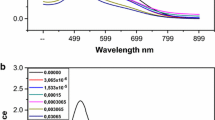Abstract
The ability to scavenge superoxide anion radicals (•O2−) was determined using an oxygen electrode. The method is based on the determination of •O2− generated by the reaction of nitrilotriacetatoiron(III) with hydrogen peroxide and a decrease in the concentration of •O2− by a scavenging reaction, converting into a change in the generation of oxygen molecules through an electron-transfer reaction from •O2− to nitrilotriacetatoiron(III). Oxygen generation, which enhanced proportionally with an increase in the concentration of hydrogen peroxide, was inhibited depending on the concentration of superoxide dismutase. Hence, we applied the present reaction system to evaluate the •O2−-scavenging abilities of an antioxidant, measuring the degree of inhibition of oxygen generation using an oxygen electrode. A good correlation was obtained between the present method and conventional colorimetry, monitoring the formation of blueformazan by the reaction of nitro blue tetrazolium with •O2−, to estimate the •O2−-scavenging activities of antioxidants.
Similar content being viewed by others
References
M. Yuasa and K. Oyaizu, Curr. Org. Chem., 2005, 9, 1685.
Y. Tian, L. Mao, and T. Ohsaka, Curr. Anal. Chem., 2006, 2, 51.
W. Domej, Z. Földes-Papp, E. Flögel, and B. Haditsch, Curr. Pharm. Biotechnol., 2006, 7, 117.
E. Meucci and M. C. Mele, Amino Acids, 1997, 12, 373.
K. Suetsuna, H. Ukeda, and H. Ochi, J. Nutr. Biochem., 2000, 11, 128.
H. L. Jackson, A. J. Cardounel, J. L. Zweier, and S. F. Lockwood, Bioorg. Med. Chem. Lett., 2004, 14, 3985.
H. Kaji, Y. Inukai, T. Maiguma, H. Ono, D. Teshima, K. Hiramoto, and K. Makino, J. Clin. Pharm. Ther., 2009, 34, 197.
O. Bozdağ-Dündar, S. Gürkan, H. Y. Aboul-Enein, I. Kruk, and A. Kładna, Luminescence, 2009, 24, 194.
Z. Xie, J. Huang, X. Xu, and Z. Jin, Food Chem., 2008, 111, 370.
K. B. Kalpana, M. Srinivasan, and V. P. Menon, Mol. Cell. Biochem., 2009, 323, 21.
K. Komagoe, H. Takeuchi, and T. Katsu, Sens. Actuators, B, 2008, 134, 516.
G. Tachiev, J. A. Roth, and A. R. Bowers, Int. J. Chem. Kinet., 2000, 32, 24.
K. Fukuzawa, T. Fujii, and K. Mukai, Arch. Biochem. Biophys., 1991, 290, 489.
C. Walling, Acc. Chem. Res., 1975, 8, 125.
H. B. Dunford, Free Radical Biol. Med., 1987, 3, 405.
C. Beauchamp and I. Fridovich, Anal. Biochem., 1971, 44, 276.
C. E. Gillbe, F. J. Sage, and J. M. C. Gutteridge, Free Radical Res., 1995, 24, 1.
W. Bors, C. Michel, and M. Saran, Biochim. Biophys. Acta, 1984, 796, 312.
C. Tai, X. Gu, H. Zou, and Q. Guo, Talanta, 2002, 58, 661.
K. J. A. Davies, M. E. Delsignore, and S. W. Lin, J. Biol. Chem., 1987, 262, 9902.
K. Sato, T. Akaie, M. Kohno, M. Ando, and H. Maeda, J. Biol. Chem., 1992, 267, 25371.
J. H. Kang and S. M. Kim, Mol. Cell, 1997, 7, 553.
H. Ukeda, Dojin News, 2004, 112, 1.
J. J. Gao, K. H. Xu, B. Tang, L. L. Yin, G. W. Yang, and L. G. An, FEBS J., 2007, 274, 1725.
Author information
Authors and Affiliations
Corresponding author
Rights and permissions
About this article
Cite this article
Komagoe, K., Takeuchi, H., Inoue, T. et al. Application of an Oxygen Electrode to Evaluate Superoxide Anion-scavenging Ability. ANAL. SCI. 26, 903–906 (2010). https://doi.org/10.2116/analsci.26.903
Received:
Accepted:
Published:
Issue Date:
DOI: https://doi.org/10.2116/analsci.26.903



